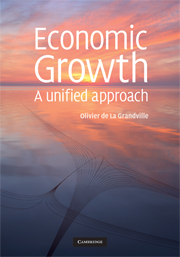Book contents
- Frontmatter
- Contents
- Introduction
- PART I POSITIVE GROWTH THEORY
- 1 The welfare of society and economic growth
- 2 The growth process
- 3 A production function of central importance
- 4 The CES production function as a general mean
- 5 Capital–labour substitution and economic growth (in collaboration with Robert M. Solow)
- 6 The long-term growth rate as a random variable, with an application to the US economy
- PART II OPTIMAL GROWTH THEORY
- PART III A UNIFIED APPROACH
- In conclusion: on the convergence of ideas and values through civilizations
- Further reading, data on growth and references
- Index
6 - The long-term growth rate as a random variable, with an application to the US economy
Published online by Cambridge University Press: 01 February 2010
- Frontmatter
- Contents
- Introduction
- PART I POSITIVE GROWTH THEORY
- 1 The welfare of society and economic growth
- 2 The growth process
- 3 A production function of central importance
- 4 The CES production function as a general mean
- 5 Capital–labour substitution and economic growth (in collaboration with Robert M. Solow)
- 6 The long-term growth rate as a random variable, with an application to the US economy
- PART II OPTIMAL GROWTH THEORY
- PART III A UNIFIED APPROACH
- In conclusion: on the convergence of ideas and values through civilizations
- Further reading, data on growth and references
- Index
Summary
A growth process is far from linear. The economy is submitted to random shocks and undergoes cycles, their length and amplitude hardly predictable. In this chapter, we will ask the following specific question: suppose that we make an estimate about the future yearly growth rates of an economy; each of these growth rates is considered as a random variable, with given mean and variance. What can we infer from those estimates about the n-year horizon expected growth rate and its variance? The answer is far from intuitive. Indeed, we might be tempted to say that the expected long-term growth rate is the expected yearly growth rate over that horizon. That this is not so will be illustrated in the following example.
We should first realize that the long-term growth rate, in the case of any variable annual growth rate, cannot be the average of the annual growth rates for the simple reason that such an average would be devoid of any meaning. Consider for instance the value of an asset growing from 100 to 300 in one year, falling then from 300 to zero in the second year. The first growth rate is R0, 1 = (300 - 100)/100 = +2 = +200%; the second one is R1, 2 = (0 - 300)/300 = -100%. The average of both growth rates is +50%, but no one would ever use that number to assess the profitability of that asset, which has in fact lost all its value. The correct long-term growth rate is the rate which transforms the initial value (S0 = 100) into the future value (S2 = 0) after two years.
Information
- Type
- Chapter
- Information
- Economic GrowthA Unified Approach, pp. 156 - 174Publisher: Cambridge University PressPrint publication year: 2009
